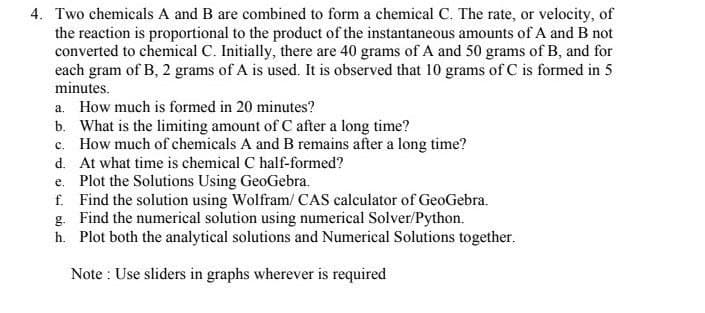Two chemicals A and B are combined to form a chemical C. The rate, or velocity, of the reaction is proportional to the product of the instantaneous amounts of A and B not converted to chemical C. Initially, there are 40 grams of A and 50 grams of B, and for each gram of B, 2 grams of A is used. It is observed that 10 grams of C is formed in 5 minutes. a. How much is formed in 20 minutes? b. What is the limiting amount of C after a long time? c. How much of chemicals A and B remains after a long time? d. At what time is chemical C half-formed? e. Plot the Solutions Using GeoGebra. f. Find the solution using Wolfram/ CAS calculator of GeoGebra. g. Find the numerical solution using numerical Solver/Python. h. Plot both the analytical solutions and Numerical Solutions together. Note : Use sliders in graphs wherever is required
Two chemicals A and B are combined to form a chemical C. The rate, or velocity, of the reaction is proportional to the product of the instantaneous amounts of A and B not converted to chemical C. Initially, there are 40 grams of A and 50 grams of B, and for each gram of B, 2 grams of A is used. It is observed that 10 grams of C is formed in 5 minutes. a. How much is formed in 20 minutes? b. What is the limiting amount of C after a long time? c. How much of chemicals A and B remains after a long time? d. At what time is chemical C half-formed? e. Plot the Solutions Using GeoGebra. f. Find the solution using Wolfram/ CAS calculator of GeoGebra. g. Find the numerical solution using numerical Solver/Python. h. Plot both the analytical solutions and Numerical Solutions together. Note : Use sliders in graphs wherever is required
Chapter8: Reaction Rates And Equilibrium
Section: Chapter Questions
Problem 8.18E
Related questions
Question

Transcribed Image Text:4. Two chemicals A and B are combined to form a chemical C. The rate, or velocity, of
the reaction is proportional to the product of the instantaneous amounts of A and B not
converted to chemical C. Initially, there are 40 grams of A and 50 grams of B, and for
each gram of B, 2 grams of A is used. It is observed that 10 grams of C is formed in 5
minutes.
a. How much is formed in 20 minutes?
b. What is the limiting amount of C after a long time?
c. How much of chemicals A and B remains after a long time?
d. At what time is chemical C half-formed?
e. Plot the Solutions Using GeoGebra.
f. Find the solution using Wolfram/ CAS calculator of GeoGebra.
g. Find the numerical solution using numerical Solver/Python.
h. Plot both the analytical solutions and Numerical Solutions together.
Note : Use sliders in graphs wherever is required
Expert Solution
This question has been solved!
Explore an expertly crafted, step-by-step solution for a thorough understanding of key concepts.
This is a popular solution!
Trending now
This is a popular solution!
Step by step
Solved in 5 steps

Knowledge Booster
Learn more about
Need a deep-dive on the concept behind this application? Look no further. Learn more about this topic, chemistry and related others by exploring similar questions and additional content below.Recommended textbooks for you


Chemistry
Chemistry
ISBN:
9781305957404
Author:
Steven S. Zumdahl, Susan A. Zumdahl, Donald J. DeCoste
Publisher:
Cengage Learning

Chemistry: An Atoms First Approach
Chemistry
ISBN:
9781305079243
Author:
Steven S. Zumdahl, Susan A. Zumdahl
Publisher:
Cengage Learning


Chemistry
Chemistry
ISBN:
9781305957404
Author:
Steven S. Zumdahl, Susan A. Zumdahl, Donald J. DeCoste
Publisher:
Cengage Learning

Chemistry: An Atoms First Approach
Chemistry
ISBN:
9781305079243
Author:
Steven S. Zumdahl, Susan A. Zumdahl
Publisher:
Cengage Learning


Chemistry for Today: General, Organic, and Bioche…
Chemistry
ISBN:
9781305960060
Author:
Spencer L. Seager, Michael R. Slabaugh, Maren S. Hansen
Publisher:
Cengage Learning

Chemistry for Engineering Students
Chemistry
ISBN:
9781337398909
Author:
Lawrence S. Brown, Tom Holme
Publisher:
Cengage Learning